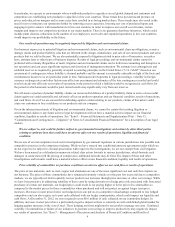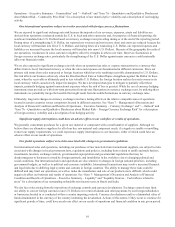Tecumseh Products 2012 Annual Report Download - page 20
Download and view the complete annual report
Please find page 20 of the 2012 Tecumseh Products annual report below. You can navigate through the pages in the report by either clicking on the pages listed below, or by using the keyword search tool below to find specific information within the annual report.19
Postretirement Curtailment Gain
In 2012, we recorded a postretirement benefit curtailment gain of $45.0 million in impairments, restructuring charges and other
items. Refer to Note 11, "Impairments, Restructuring Charges and Other Items" and Note 5, "Pension and Other Postretirement
Benefit Plans" of the Notes to Consolidated Financial Statements in Item 8 of this report for further information.
Liquidity
Challenges remain with respect to our ability to generate appropriate levels of liquidity solely from cash flows from operations,
particularly related to uncertainties of future sales levels, global economic conditions, currency exchange rates and commodity
pricing as discussed above. In 2012, however, we generated $8.8 million of cash flow from operations. Our net income
included the following non-recurring cash inflows: a $4.4 million refund from the IRS related to a previously unrecognized tax
benefit and $1.3 million in interest income related to the refund, income of $2.9 million due to the sale of proceeds from a
future potential settlement of a lawsuit involving our Brazilian location and a $1.7 million payment received from a mutual
release agreement that we signed in the second quarter of 2012.
We have received cash inflows from non-operating activities and expect to receive further cash inflows from recoverable non-
income taxes through the end of 2014. We have received and expect to receive refunds of outstanding Indian and Brazilian non-
income taxes. In 2012, we received approximately $15.8 million and $9.2 million of outstanding refundable non-income taxes
in India and Brazil, respectively. Due to changes in exchange rates, the actual amounts received as expressed in U.S. Dollars
will vary depending on the exchange rate at the time of receipt or future reporting date.
We expect to recover approximately $15.9 million of the $32.5 million outstanding refundable taxes in Brazil and $3.9 million
of the $6.1 million outstanding refundable taxes in India, in 2013. The tax authorities will not commit to an actual date of
payment and the timing of receipt may be different than planned if the tax authorities change their pattern of payment or past
practices.
We realize that we may not generate cash flow from operating activities unless further restructuring activities are implemented
or sales or economic conditions improve. As a result, we continued to adjust our workforce levels as conditions demanded in
2012 to reduce salary, wages and employee benefits. Total realized savings on an annual basis were approximately $4.0 million
and incurred a charge of $3.8 million associated with this restructuring plan. The realized savings in 2012 are consistent with
our initial estimates. Additional restructuring actions may be necessary and might include changing our current footprint,
consolidation of facilities, other reductions in manufacturing capacity, further reductions in our workforce, sales of assets, and
other restructuring activities. These actions could result in significant restructuring or asset impairment charges, severance
costs, losses on asset sales and use of cash. Accordingly, these restructuring activities could have a significant effect on our
consolidated financial position, operating profit, cash flows and future operating results. Cash required by these restructuring
activities might be provided by our cash balances and the cash proceeds from sales of assets. If such restructuring activities are
undertaken, there is a risk that the costs of the restructuring and cash required will exceed the benefits received from such
activities. We have engaged a financial adviser and are exploring our strategic alternatives.
On April 21, 2011, we entered into a Revolving Credit and Security Agreement with PNC Bank, National Association (“PNC”).
Subject to the terms and conditions of the agreement, PNC agreed to provide us with up to a $45.0 million revolving line of
credit, including up to $10.0 million in letters of credit, subject to a borrowing base formula, lender reserves and PNC’s
reasonable discretion. The facility expires on April 21, 2015 and bears interest at either LIBOR or an alternative base rate, plus
a margin that varies with borrowing availability. At December 31, 2012, our borrowings under this facility totaled $10.0
million, and we have an additional $2.1 million of borrowing capacity under the borrowing base formula after giving effect to
our fixed charge coverage ratio covenant and $3.4 million in outstanding letters of credit. As of December 30, 2011, we entered
into Amendment 1 to the Revolving Credit and Security Agreement with PNC to amend certain non-financial covenants. We
were in compliance with all covenants and terms of the agreement at December 31, 2012.
We also continue to maintain various credit facilities in most jurisdictions in which we operate outside the U.S. While we
believe that current cash balances and available borrowings under our credit facilities and cash inflows related to non-income
tax refunds will produce adequate liquidity to implement our business strategy over the foreseeable future, there can be no
assurance that such amounts will ultimately be adequate if sales or economic conditions deteriorate. We anticipate that we will
restrict non-essential uses of our cash balances until cash provided by normal operations improves.
In addition, while our past business dispositions have improved our liquidity position, many of the sale agreements provide for
certain retained liabilities and indemnities including liabilities that relate to environmental issues and product warranties. While
we believe we have properly accounted for such contingent liabilities based on currently available information, future events
could result in the recognition of additional liabilities that could consume available liquidity and management attention.
























